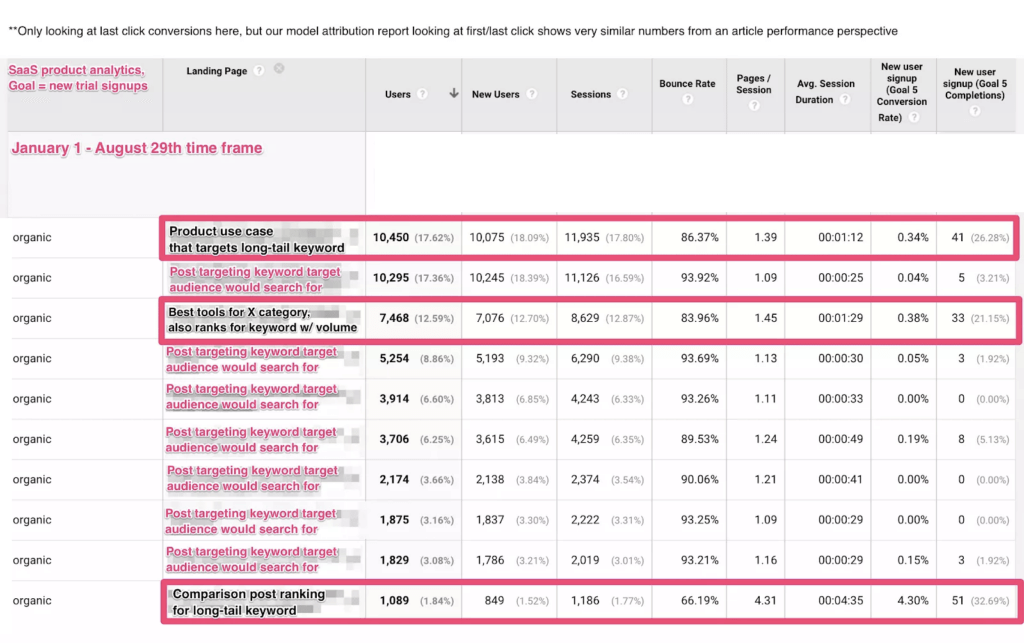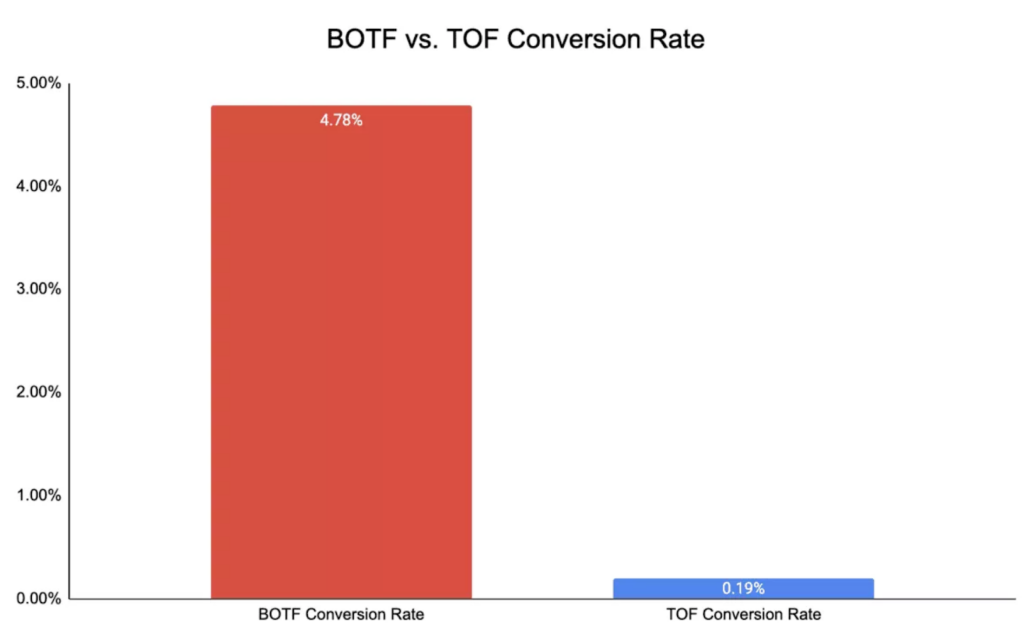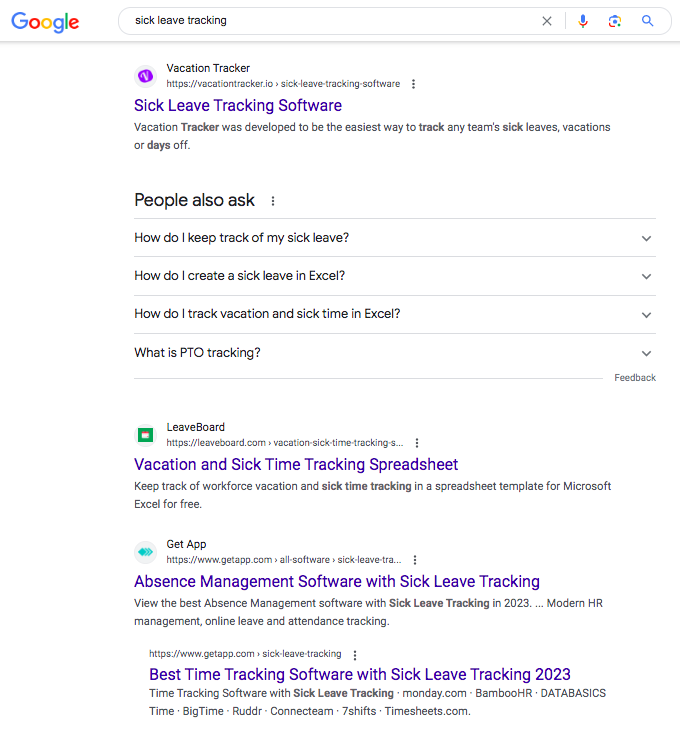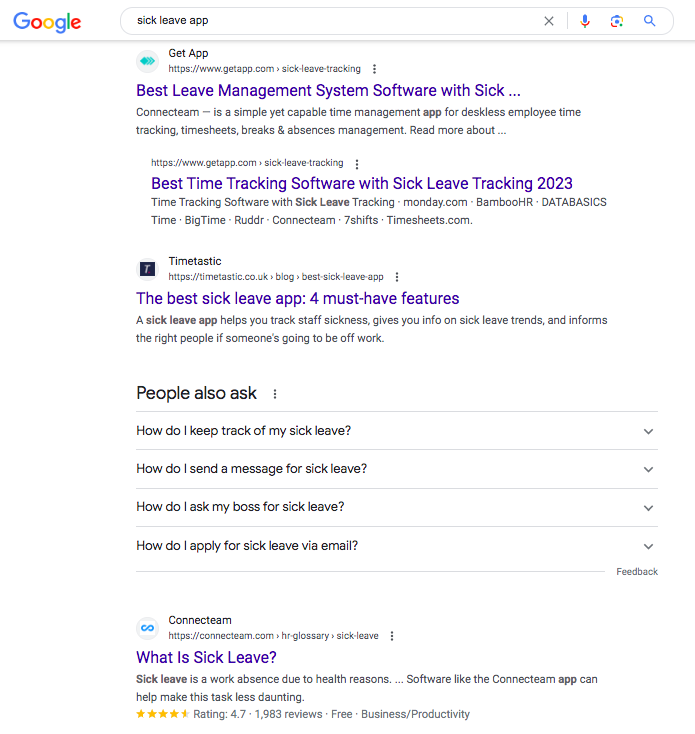An SEO conversion is when a visitor finds your website through organic search and completes a product or sales-related action (e.g., fills out a contact form, signs up for a free trial).
When the topic of improving SEO conversion rates comes up, many marketers jump straight into advice centered around conversion rate optimization (CRO) — the process of making small tweaks to a website to increase the conversion rate of a desired action, for example, implementing pop-ups and email list opt-ins, making technical adjustments to decrease page load time or bounce rate, or A/B testing different calls to action (CTAs).
While these user experience (UX) design tweaks and conversion optimization tactics are fine, in our experience they aren’t nearly as impactful as prioritizing and ranking for keywords where the people searching indicate they’re on the market looking to buy what you sell — we call these “high buying intent keywords.”
In this article we’re going to share examples and data — based on the last 5 years tracking conversions of hundreds of blog posts for our clients — to back this up. Then, we’ll share other key learnings that have helped us maximize SEO conversions for our clients, as we’ve demonstrated in numerous in-depth case studies.
Below, we cover:
Why Ranking for High Buying Intent Keywords Is the Most Important Aspect of Improving SEO Conversion Rates
As we’ve discussed at length many times, most businesses, in-house marketers, content marketing agencies, and SEO agencies use traffic-focused SEO strategies. These strategies are based on the assumption that with enough website traffic, conversions will inevitably follow.
In practice, this means they prioritize keywords that have high search volume, but low to zero buying intent. For example, if you sell employee scheduling software, this might mean targeting keywords such as “how to become a better manager” or “minimum wage by state.”
While these keywords could potentially be searched for by your audience and likely have high search volumes that could drive substantial organic traffic, searchers of these terms show no indication that they have intent to buy employee scheduling software. (If they did, they’d be more likely to Google a term with clear buying intent such as “best employee scheduling software” or “employee scheduling app for small business.”)
As a result, by our measures, these keywords have very low conversion rates. And trying to solve that by making CRO tweaks or UX improvements to your site is unlikely to make much of a difference because the website visitors coming in from those keywords aren’t even on the market for what you sell in the first place.
If you’re a B2B or enterprise SaaS company selling employee scheduling software, is a pop-up with the right messaging or a sidebar CTA really going to convince someone that they all of the sudden need your product? In our experience, no.
Could these tactics work for generating email subscriptions or selling low cost eCommerce products? Maybe (because these are much smaller asks) — but they’re still unlikely to impact conversion rates in the way that ranking for high buying intent keywords will.
This point is neatly summarized in this analytics screenshot from our article on Pain Point SEO (our agency’s foundational SEO strategy):

The right most column shows new user signups for each of the URLs listed. The three boxed posts follow the Pain Point SEO approach and rank for keywords with high buying intent. The rest rank for something the target audience could search for, but not a high buying intent keyword.
The new user signups from the three Pain Point SEO posts are hundreds of percent higher.
We also showed this at a larger scale in an analysis of 60+ posts for our client Geekbot:

The posts targeting high buying intent keywords (which we’ve traditionally referred to as “bottom of funnel”) didn’t just convert a bit better than the higher-volume-lower-intent posts, they converted 2400% better.
In that case study, you can read about how the higher conversion rates more than made up for any differences in search volume or traffic between the two buckets.
By all means, follow CRO best practices, but don’t expect that to be the thing that will improve your conversion rates. Instead, focus on ranking for as many high buying intent keywords as possible.
As you do, take into consideration the following 3 factors:
3 Key Factors to Consider When Developing and Executing a Conversion-Focused SEO Strategy
1. There’s Way More Buying Intent Keywords Than Most Businesses Realize
For many companies, the basic approach to SEO looks something like this:
- Homepage: Optimize the homepage for one or two product or service category keywords. These are high buying intent keywords that describe what the company sells. For example, “executive assistant service” or “PPC reporting software.”
- Service or product pages: Optimize a small handful of product or service pages (or feature and solutions pages in SaaS) for similar high buying intent keywords that describe the product or service.
- Blog: Use the blog to go after high search volume but low buying intent keywords as we discussed above. The blog is considered a tool for generating brand awareness and getting potential customers in your “conversion funnel,” not an asset for ranking for buying intent keywords and selling your service (more on this below).
In this scenario, companies are only targeting a small handful of buying intent keywords (maybe 5 to 10). But in our experience, this typically leaves a ton of buying intent keywords on the table.
Why?
First off, people often describe products and services in many different ways. For example, any given software may be described as:
- “Software” (e.g. “small business accounting software”)
- “Tool” (e.g. “project management tool”)
- “Platform” (e.g. “marketing analytics platform”)
- “App” (e.g. “field service app”)
It’s common for there to be several different keyword variations for your product or service. And if a business serves multiple industries or verticals, the list of variations grows longer. As we’ll discuss below, you simply won’t rank for all of these with your homepage and a small handful of product or service pages.
Furthermore, there are two other high intent keyword frameworks — competitor and alternatives keywords, and jobs to be done keywords — that can drive significant conversions, but are not going to be ranked for with home and product or service pages.
Companies should leverage blog content to go after all of these additional high intent opportunities — as we do at our agency — but most do not.
Note: Pair this post with our article on SEO keyword strategy to aid you in your own keyword research.
You can also check out our YouTube video for Semrush Academy:
2. Target Each High Intent Keyword with a Single, Dedicated Page That Deeply Satisfies Search Intent
People in search engine optimization often try to target many different keywords with a single web page. But search engines don’t reward this approach like they used to. As algorithms have evolved, the approach of trying to rank for a bunch of keywords (especially competitive buying intent keywords) with a single page rarely works.
One of our key learnings in recent years (and a differentiator of our agency’s strategy) is that the best way to get top positions for high intent keywords is to create a dedicated page for each one — even when keywords have very similar meanings.
For example, consider the keywords “sick leave tracking” and “sick leave app.” You can imagine that the intent behind these two search terms is nearly identical: searchers are looking for a tool to track employee sick leave.
But when you look at search results for these two terms, the top results are different.
Here are the results for “sick leave tracking”:

And here are results for “sick leave app”:

Although intent is very similar, Google is ranking different pages for these terms, which indicates an opportunity to create dedicated pages to go after each of these keywords.
As we discussed in our conversation with Bernard Huang of Clearscope, you only get one SEO title, one H1 heading, one meta description, etc. If you try to rank for multiple target keywords with one piece of content, often it will only end up ranking for one of them (or worse, you won’t match the intent of any individual keyword, and you won’t end up ranking for any of them).
Note: We’ve documented the exact process we use when analyzing search engine results pages (SERPs) for target keywords in our post on SEO content writing.
3. Sell Your Product in Each Piece of Content
Many SEO’s and content marketers barely discuss the company’s product or service inside of the blog content they write. They’ll sometimes glancingly mention and link to a product or service page in their content, but they often just rely on design elements of the page (e.g. pop-ups, email list opt-in forms, CTA graphics, etc.) to “take care of conversions.”
We think this mistake is related to the problem discussed above — the tendency to prioritize keywords with high traffic potential but low buying intent. The advice that’s typically paired with that practice is to “not be too salesy” in your blog content: “just give the customer advice and value and they’ll like your brand and (fingers crossed) remember you later when they need to buy” (not likely).
In our experience, even if you’re writing about top of funnel topics that aren’t product-focused, you need to weave in a compelling discussion of your product or service if you want your content to convert.
Particularly if you focus on high buying intent keywords, this necessitates discussing your product or service in order to meet search intent.
If someone is doing a Google search for “best employee scheduling software”, their intent is to learn about the details of various options. They want to know what’s better about this software option versus that one, how they compare, which is better for whom, and more.
Discussing those product related ideas isn’t “being salesy” for this search query, it’s just fulfilling search intent! So, whether you go after that keyword with a landing page or a blog post, the content of the page needs to discuss your product or service in-depth.
How to Track SEO Conversions in Google Analytics
At a high-level, there are 3 steps to set up conversion tracking in Google Analytics 4 (GA4):
- Create “Conversion Events”. In Universal Analytics (UA), the previous version of Google Analytics, conversions were typically tracked by setting up what were called “Conversion Goals.” However, in Google Analytics 4 (GA4), conversion tracking is based on “Conversion Events.” You do that by first creating events you want to track and then marking the ones of interest as a “Conversion” event. These must be set up in order to access or create custom reports to view conversion data for the specific events you want to track.
- Consider which attribution models you’ll use in your reports. An attribution model is a conversion counting method that determines how credit for conversions is assigned to touchpoints on conversion paths. No single attribution model will give you a complete and accurate view of your conversion data, so we recommend setting up multiple reports that use different models to get the best understanding of your conversion data.
- Access or create reports to view and track your conversion data. GA4 offers a default conversion report which can provide a high-level overview of conversion performance. However, it’s useful to leverage additional custom reports to build up a more holistic view of your conversion data. We use the model comparison tool as well as an any touchpoint report.
We’ve created two long-form pieces of content that explain how to track and report on SEO conversions in GA4.
First, we wrote a step by step tutorial on how to set up SEO conversion tracking in Google Analytics 4 (GA4). Check that out for the full explanation.
Second, we created a long-form video walkthrough explaining the process:
What Is a Good SEO Conversion Rate?
Over the years, we’ve had a number of conversations with clients where they’ve expressed that they feel their organic conversion rate is low compared to what they thought was good.
We think this is partially a result of companies using paid conversion rates as a benchmark for overall organic conversion rates. For example, they might see that their average conversion rate from Google Ads is ~3%, while their average overall conversion rate from organic search is somewhere in the 0.1%-0.3% range, and then conclude that their organic conversion rate is very low.
However, as we discussed at length in our deep dive video on average blog conversion rates, oftentimes the way companies look at their organic conversion rates is flawed. Specifically, they don’t segment out the different parts of their site and different mediums of traffic which skew conversion rates and make them seem higher or lower than they should be.
To gain a deeper understanding of what makes a good conversion rate, and how to more accurately measure your conversion rates from SEO, check out the video:
In the video we share conversion rate data from two different clients of ours — both a mid-market/enterprise demo based SaaS company and a B2SMB self service SaaS company — and show how we’re getting 2%+ average conversion rates on our blog posts and compare those stats to how their sites convert overall from organic.
We share data on what we’ve seen for average blog conversion rates and explain what we think a good conversion rate target should be for each individual blog post.
In general, as we share in the video, a good SEO conversion rate for pages ranking for bottom of funnel keywords is between 1% – 5%. Anything above that is great. And in general, for an entire blog or content operation that largely focuses on bottom of funnel pieces, a conversion rate of 0.5% to 2% from visitor to lead, trial start, or eCommerce sale is good.
Lastly, we share 3 examples of us outranking landing pages with blog posts and debate why we think blog posts are usually better to go after high intent keywords with — and how we think they may have higher conversion rates (even if the landing page were to rank higher than our blog post).
How to Measure the ROI of SEO
Most marketing agencies and in-house teams struggle to find answers to these questions:
- What’s our return on investment (ROI) from content?
- What can we expect our ROI from content to be?
In this post, we walk through our process for answering both of those questions. We also have YouTube videos on why you shouldn’t measure all content as a whole (you should instead measure ROI from individual pieces of content) and how to calculate the value of SEO.
Learn More About Our SEO and Content Marketing Agency
- Our Agency: If you want to hire us to execute a content-focused SEO strategy built around driving lead generation and sales, not just traffic, you can learn more about working with us here.
- Join Our Content Marketing Team: If you’re a content marketer or writer and would love to do content marketing in this way, we’d love to have you apply to join our team.
- Our Content Marketing Course: Individuals looking to learn our agency’s content strategy and become better marketers, consultants, or business owners can join our private course and community, taught via case studies, and presented in both written and video content formats. We include several details and examples not found on this blog. Our course is also built into a community, so people ask questions, start discussions, and share their work in the lesson pages themselves, and we, along with other members, give feedback. Learn more here.








